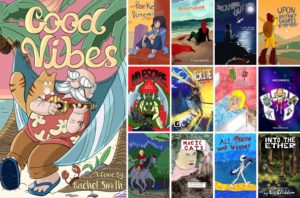Camosun Comics and Graphic Novels students are getting ready to show off their 28-page comics at the sixth annual Camosun Comic Arts Festival. Comics and Graphic Novels program co-founder Ken Steacy says tabling—where students put their work on a table and interact with passers-by about what they’ve created—is an important part of growth in the industry.
“They have to create a display for their table, they interact with the public—their audience—and get to talk about their work and get feedback,” says Steacy.

There will also be professional mentors there who will spend the morning working with the students individually (some mentors include Gareth Gaudin of Legends Comics and Books and Perogy Cat fame, and Jess Pollard, who designed the poster for the festival this year; the festival will also have Scott Chantler, creator of graphic novel Two Generals, as a guest speaker). In the afternoon, those mentors will display their work.
“It’s a sizable convention,” Steacy says. “Hundreds of people are displaying, so you have to have something that’s going to stop people in their tracks and [make them] say, ‘Wow, this is really cool. Interesting. Tell me about this.’”
Steacy stresses the importance of students being an active participant in their tabling.
“For many years, you’d see people with their heads down, just drawing or knitting or whatever,” says Steacy, with a laugh. “But it’s really important that they actually are standing up and smiling at people and greeting people and so on, because—it’s interesting—shyness is still an issue, both with artists and attendees.”
Steacy says the impetus is on the students tabling to be the one to get the interactions going, which is another skill students can learn at the event.
“Break the ice… just engage people,” says Steacy. “People who attend these conventions are there because they’re invested in popular culture in the same way that we are, and they’re looking for something. But they may just need that little prompt.”
Steacy says the collision of words and pictures that makes up visual storytelling is a delicate balance.
“That in and of itself creates a synergy,” he says. “That is one plus one equals three; the whole is greater than the sum of its parts. So the challenge, of course, is the modulation of words and pictures determining how much narrative, how many word blurbs, how many captions, and so on, are required to move the story forward.”
Steacy says that just because comics are a visual medium doesn’t necessarily mean that students have to be good artists, but he does say that length is always a challenge, particularly in our culture.
“In Japan, comics can run for 300 and 400 and 500 pages, so you actually have the opportunity to do beautiful, very nuanced sequences where somebody can flick a cigarette away and we can watch it tumble and hit the ground, and the coals fly and the wind blows and then a leaf goes by… they’re exquisite,” says Steacy.
But North American comics, in general, are much shorter.
“You’ve only got approximately 22, 24 pages to tell a story, so you couldn’t take four or five pages just to do a scene like that,” he says. “That would happen maybe in a couple of panels.”
Camosun Comic Arts Festival
12 pm until 5 pm, Saturday, April 14
Free
Third floor, Young building, Lansdowne campus, Camosun College
camosun.ca/learn/programs/comics-graphic-novels/ccaf/
